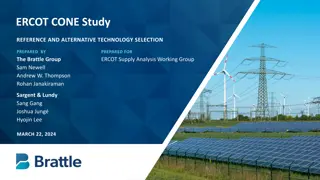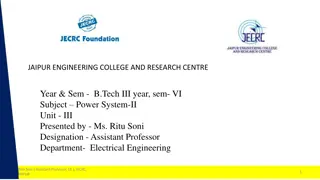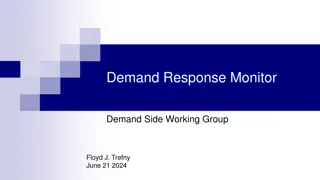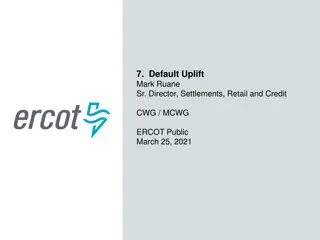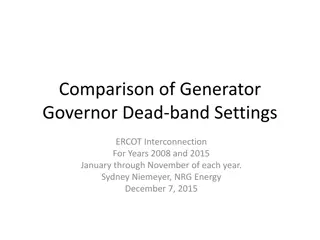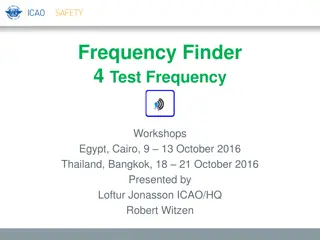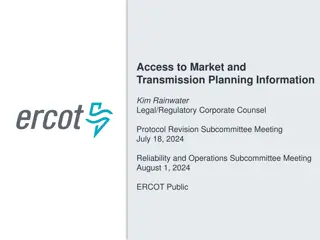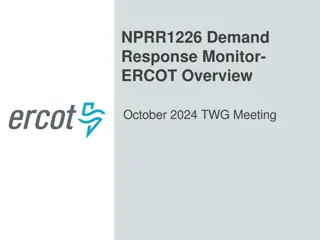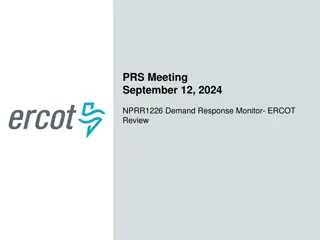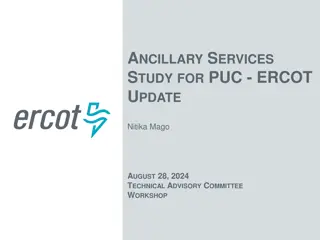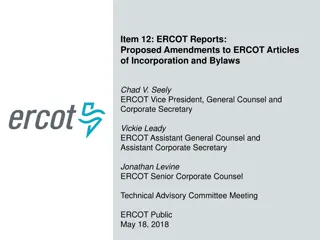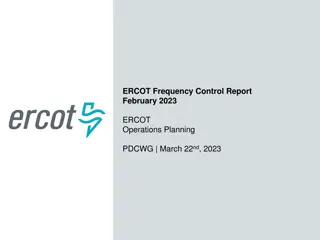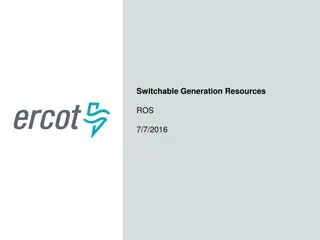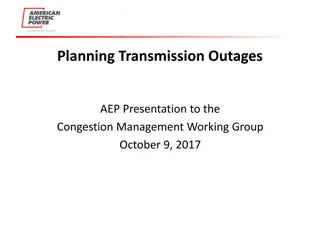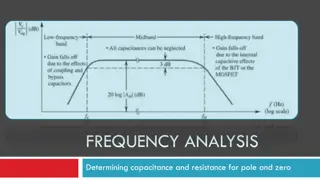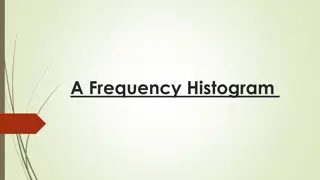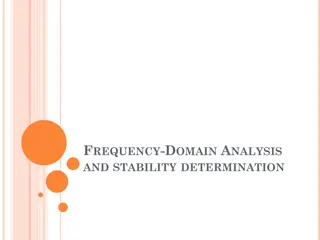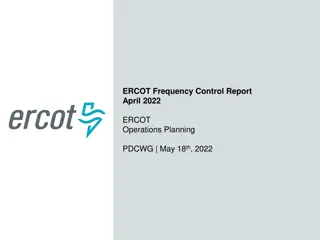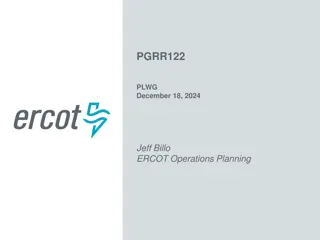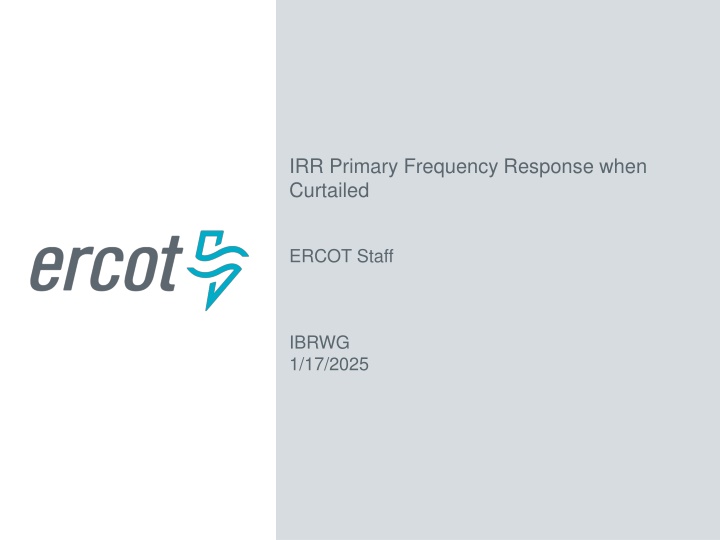
ERCOT's Primary Frequency Response Challenges
ERCOT's struggle with primary frequency response requirements for online resources is highlighted, showcasing insights from OEMs and potential solutions discussed at IBRWG meetings.
Download Presentation

Please find below an Image/Link to download the presentation.
The content on the website is provided AS IS for your information and personal use only. It may not be sold, licensed, or shared on other websites without obtaining consent from the author. If you encounter any issues during the download, it is possible that the publisher has removed the file from their server.
You are allowed to download the files provided on this website for personal or commercial use, subject to the condition that they are used lawfully. All files are the property of their respective owners.
The content on the website is provided AS IS for your information and personal use only. It may not be sold, licensed, or shared on other websites without obtaining consent from the author.
E N D
Presentation Transcript
IRR Primary Frequency Response when Curtailed ERCOT Staff IBRWG 1/17/2025
Agenda ERCOT PFR expectation IBRWG/OEM discussions What ERCOT is seeing from IRRs Potential approach to deal with the concerns 2 PUBLIC
Grid Code : Primary Frequency Response Requirement All online resources are required to assist in ERCOT s frequency control and provide a governor-like response to frequency deviations when they have headroom/legroom. Max. Droop % Setting Generator Type Combustion Turbine (Combined Cycle) 4% All Other Generating Units/Generating Facilities/ESRs/Controllable Load Resources 5% ERCOT is noticing that several IRRs when curtailed to low ouput(including down to zero) are failing BAL-TRE-001 evaluation. We have been talking with the OEMs to understand the capabilities and limitations of various technologies providing PFR when curtailed. OEMs brought this issue to the IBRWG for further discussion and potential resolution. 3 PUBLIC
What we heard in IBRWG meetings With IBRWG help, ERCOT got following feedback from OEMs At the Sep 16, 2024 IBRWG meeting, Vestas presented that their Wind Turbine s will disconnect or enter pause mode when curtailed below controllable active power range including when curtailed to 0 MW. Vestas further proposed potential solutions for the limitations and capabilities that may be Vestas-specific : 1) Creating BAL-001-TRE-2 exclusion for response limitation, 2)Introducing a non-zero LSL and 3)Separate HSL for dispatching vs PFR. At the Oct 11 2024 IBRWG meeting, SMA and other anonymous solar OEM presented that their inverters does not have any limitations in providing PFR during deep curtailments. At the Nov 15, 2024 IBRWG meeting, Nordex presented that their Wind Turbine s will disconnect when curtailed below Technical Minimum(TM) (10% of rated power) or curtailed to 0 MW. Nordex proposed potential solution to introduce a TM for frequency control, excluding PFR contribution below this minimum operating limit. Industry expert from HickoryLedge presented that the active power control at low power levels, whether due to deep curtailments or low wind speed is extremely challenging and subject to multiple physical and stability constraints. 4 PUBLIC
What we are seeing from IRRs 5 PUBLIC
What we are seeing from IRRs 6 PUBLIC
What we are seeing from IRRs 7 PUBLIC
What we are seeing from IRRs 8 PUBLIC
What we are seeing from IRRs 9 PUBLIC
ERCOTs thoughts on potential approach for this issue To maintain ERCOT system reliability, ERCOT may have to curtail the IRR units down to 0 MW and a non-zero LSL for the IRRs may hamper the curtailment. The parameters that limit the capability to provide PFR when curtailed seems to vary based on the OEM, real-time operating conditions, state of the equipment, etc. Furthermore, there was no feedback from several other OEMs on their limitations during these discussions. Recognizing that during real-time there can be operating conditions during which some wind resources may not be able to provide PFR, A change that can be implemented relatively quickly without impacting ERCOT s reliability is to add this as an additional exclusion to the BAL-001-TRE-2 PFR exclusion process. Doing so will allow ERCOT to assess the extent of this issue. ERCOT may propose additional solutions in the future as we gain more knowledge on the limitations and capabilities of the IRRs during curtailment. ERCOT is seeking IBRWG s inputs on this approach. 10 PUBLIC
DISCUSSION 11 PUBLIC

